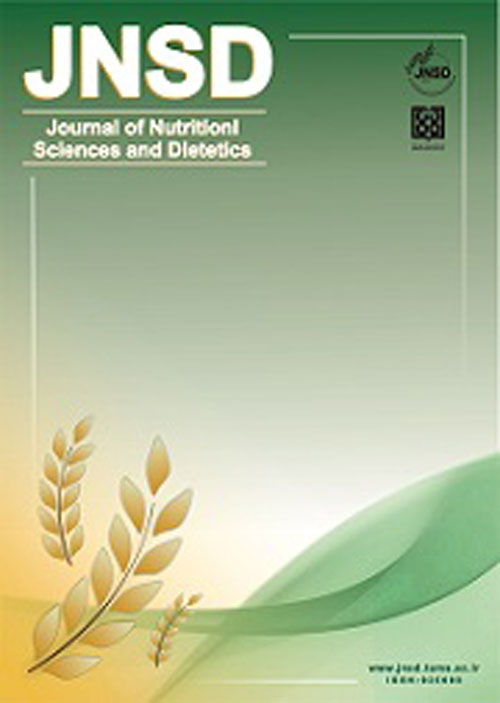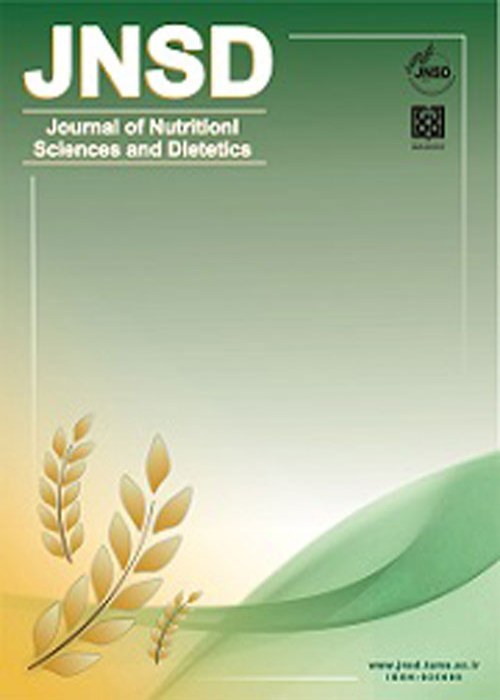فهرست مطالب

Journal of Nutritional Sciences and Dietetics
Volume:4 Issue: 2, Spring 2018
- تاریخ انتشار: 1397/06/18
- تعداد عناوین: 7
-
-
Page 3Background
Intensive exercise increases inflammatory biomarkers such as C-reactive Protein (CRP) and Interleukin 6 (IL-6). Dietary antioxidants can alter this inflammatory/oxidative state.
ObjectiveThe aim of this study was to determine the effect of tomato juice (and not supplement) consumption as a rich source of lycopene (a potent antioxidant) on inflammatory biomarkers of male athletes following exhaustive exercise.
MethodsThirty male university students were enrolled and randomly divided into two groups. The experimental group consumed 200 mL tomato juice daily (containing 50 mg of lycopene) for one week, and then performed exercise on treadmill at a speed of 18 km/hour till exhaustion. The control group consumed the same amount of water and performed the same exercise regimen. Blood samples were collected pre- and immediately post-exercise for analysis of IL-6, CRP and oxidant/antioxidant ratio. IL-6 and CRP were measured using ELISA. Oxidant /antioxidant ratio was measured by colorimetric assay. Statistical analysis was undertaken using SPSS-13.
ResultIn the group who consumed tomato juice, CRP levels were significantly reduced post exercise compared to pre-exercise. The levels of IL-6 and oxidant/antioxidant ratio did not change after exercise in either the tomato juice or control groups.
ConclusionOur data showed for the first time that consumption of tomato juice, which is a main source of the antioxidant lycopene, can lead to a decrease in systemic inflammation post-exercise. This may provide a useful approach for protecting against inflammation-induced muscle damage and improving exercise performance in athletes.
Keywords: Lycopene, Inflammatory bio, marker, Tomato juice, Exhaustive exercise -
Page 10
Stress reduction, plays an important role in the prevention of different disorders such as blood pressure, obesity, ulcers, nervousness, problems with memory and etc. Proper lifestyle and healthy diet habits could keep stress under control. Some preliminary researches, demonstrated the effect of food-derived bioactive peptides on stress reduction. The aim of this study was to investigate the effect of daily consumption of 12 g sugar-free chocolate containing 150 mg peptide (aS1-casein (91-100)) on stress reduction in healthy normal-weighted participants. Clinical assessments included self-rated questionnaires and saliva cortisol level, which were recorded and analyzed before and after chocolate consumption for 2 weeks. Sixty participants completed the Cattle Inventory (CI), the Beck Depression Inventory (BAI) and the Depression Anxiety Stress Scales (DASS) questionnaires. To determine the thermal and mechanical stability of the peptide during chocolate processing, FTIR and HPLC were used. Results showed that consumption of peptide containing chocolate reduced anxiety and stress scores in questionnaire and cortisol level in saliva, significantly (P
Keywords: bioactive peptide, stress reduction, sugar, free chocolate, cortisol measurement, stress questionnaire -
Page 25Background
Specific amino acids seem to have crucial role in the management of critically ill patients. This study aimed to compare the effect of L-arginine and L-citrulline supplementation on overall prognosis of critically ill patients.
MethodA total of 105 head trauma ICU patients were recruited in this double-blind randomized clinical trial. Patients in the treatment groups took 10 gr per day oral L-Arginine or L-citrulline for 10 days. Demographic characteristics and anthropometric measurements were recorded. Nitric oxide (NOx), pre-albumin, pro-oxidant, anti-oxidant balance, fasting blood sugar, lipid profile, liver enzymes, serum electrolytes, blood urea nitrogen, creatinine and serum amino acids were measured. Gastrointestinal complications, ventilator need, length of hospital stay and 28-day mortality were recorded. The K2 testing system was used to compare the qualitative variables. Repeated measures ANOVA were used to compare means across variables. In case of significant time-group interaction, between group comparisons of changes at day 11 were done using ANOVA followed by Tukey or Mann Whitney analysis. When time effect factor was significant, the within-group comparison of values was performed by paired samples t test or Wilcoxon.
ResultsWe observed no significant changes in NOx and PAB (P= 0.8, P= 0.1 respectively). There was a significant increase in serum LDL (P= 0.02) which was higher in the control group after 10 days of supplementation. There was non-significant increase in serum L-arginine in all three groups (P=0.36). However, changes of serum L-arginine was significant in the citrulline group (P=0.048). Serum L-citrulline was higher in the citrulline group compare to the arginine group (P=0.04).
ConclusionL-arginine and L-citrulline supplementation did not increased NOx levels more than the control group. Also, PAB balance was not different among the intervention groups and the control group. L-arginine and L-citrulline had no significant effects on length of hospital stay, mortality rate, ventilator need and other factors evaluated in this study.
Keywords: L, arginine, citrulline, head trauma, ICU -
Page 34Background
Obesity and its physical and psychological consequences is a multi-factorial status and relate to several factors including genetics, lifestyle, and body image (BI). Therefore, an accurate understanding of the leading causes and establishing appropriate approaches for its control, would be an important issue. The aim of this study was to evaluate the body image perception in schoolchildren and its relationionship with maternal perception of child weight and some lifestyle factors in Tehran, Iran.
Material/patients and MethodsIn this cross-sectional weight status of 1598 children was categorized according to the World Health Organization reference charts of body mass index in Tehran, Iran. The Collins Seven Figure Scale and a pretest questionnaire was used to assess the body image and some lifestyle factors in children and mothers of obese children. The relationship between variables and body image was analyzed using chi-square and logistic regression analyzes in SPSS (version.19).
Results72.4% of obese and 51.8% of non-obese children did not have an accurate body image. 60.2% of bese children`s mothers had an accurate perception of their children`s body image. Among all variables, a significant correlation was found between obese children and their mother`s body image (P=0.005) and father`s educational level(P=0.002).
ConclusionIt was found that most obese school children had an inaccurate perception of body image .Mothers of obese children had better body image perception of their children. It is suggested that regarding with better perception of body image, improving lifestyle factors would be important in prevention and control of obesity .
Keywords: Body image, Childhood, Obesity, Maternal perception, Lifestyle -
Page 41Background
Due to increasing prevalence of overweight and obesity among adolescents, monitoring of the correlates of body weight is of utmost importance.
ObjectiveThis paper examines the prevalence and correlates of overweight and obesity among 14-18 year-old adolescents of Shiraz-Iran.
MethodsUsing a multistage random sampling 289 males and 249 females, were recruited. Daily physical activity, calorie intake and other important information was obtained using two days 24 hour recall of physical activities, a semi quantitative food frequency questionnaire and a self-administrative questionnaire respectively. Height, weight and BMI z-scores were measured based on standard protocols.
ResultsPrevalence of overweight and obesity was 18% and 6.7% respectively. Prevalence of overweight including obesity was associated negatively with socioeconomic status of school area (χ²=6.6, p=0.037), fathers total years of schooling (13.5% vs. 41.4% and 45.1%), supplement consumption (χ²=6.0, p=0.015), energy density of foods (χ²=10.3, p=0.006) but was positively associated with calorie restraint (χ²=7.9, p=0.005), family history of obesity (χ²=14.8, p=0.000), sleep disturbances (χ²=14.1, p=0.042) and body satisfaction (χ²=13.1, p=0.001). Socioeconomic status of school area (OR=1.9, 95% CI=1.1-3.2), supplement consumption (OR=0.2, 95% CI=0.1-0.8), calorie restraint (OR=3.0, 95% CI=1.5-5.8), family history of obesity (OR=1.9, 95% CI=1.2-2.9), body satisfaction (OR=1.9, 95% CI=1.1-3.4) energy density of foods (OR=0.5, 95% CI=0.2-0.9) and sleeping hours (OR=1.7, 95% CI=1.1-2.6) contributed significantly to overweight after controlling for other variables.
ConclusionsFindings of this study showed that overweight/obesity was prevalent among Iranian adolescents. Encouraging adolescents especially those with a positive family history of obesity to follow more favorable lifestyle may markedly protect them against onset of obesity and its psychosocial and physical consequences.
-
Page 50Purpose
Accumulating evidence suggests vitamin D play a role in autoimmune diseases. However, at this time the finding on its role in autoimmune and thyroid disease is not conclusive. Then, we aimed to review and update data on the effectiveness of vitamin D on thyroid auto antibodies, anti-TPO and anti-TG in adults.
MethodsScopus and PubMed search engines were used up to February 2018 for clinical trials without any restriction in time and language. The outcome parameters were thyroid auto antibodies, anti-TPO and anti-TG. We included studies which reported aim parameters. Results were summarized as mean differences (MD) with 95% confidence intervals (CI). Effect sizes were pooled using random-effects models (the DerSimonian-Laird estimator).
ResultsEight trials involving 526 subjects were included in this meta-analysis. Vitamin D supplementation did not significantly changed the serum level of anti-TPO (MD: -46.901 IU/mL, 95% CI: -111.841, 18.039, p=0.157) and anti-TG (MD: -0.903 IU/mL, 95% CI: -2.208, 0.401, p = 0.175) with high heterogeneity (I2= 77.1%, p= 0.000, I2= 26.5%, p= 0.253). Anti-TPO reduction was considerable in mixed-sex and low quality trials, doses of ≥ 1000 IU, periods of ≥ 2 months , AITD patients and in subjects with lower initial serum levels of vitamin D and higher initial serum level of anti-TPO (p
ConclusionsVitamin D supplementation did not improve the serum levels of anti-TPO and anti-TG. The effects of vitamin D supplementing on AITD should be further investigated by conducting larger sample size and well-defined trials of long enough duration.
Keywords: Autoimmune disease, Vitamin D, Antibody, Autoimmune thyroid disease, Hashimoto disease


